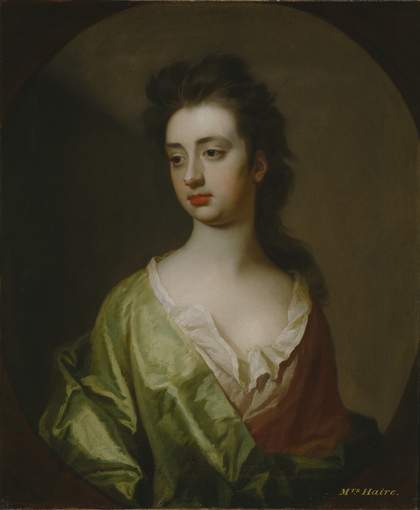
Fig.1
Michael Dahl 1659–1743
Portrait of Mrs Haire 1701
Oil paint on canvas
768 × 639 mm
T06499
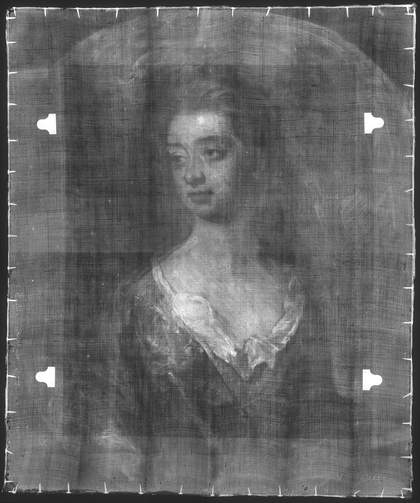
Fig.2
X-radiograph of Portrait of Mrs Haire 1701. The modern mirror plates for securing the canvas in its frame, attached to the back of the stretcher, are rendered as bright white shapes.
This painting is in oil on canvas measuring 742 x 620 mm (fig.1). The plain woven, linen canvas has 12.5 horizontal x 14.5 vertical threads per square centimetre (fig.2). It is unlined, although the stretcher is not the original; crack marks in the painting indicate that the original was a simple rectangle with bars about 50 mm wide. Cusping on all four sides of the canvas shows that the painting has not been reduced in size.1
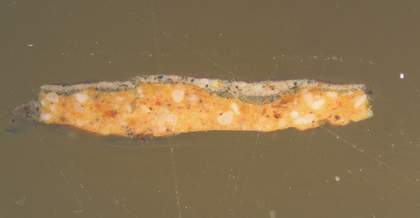
Fig.3
Cross-section through the greenish brown background at the right edge, photographed at x200 magnification. From the bottom: tan coloured ground; opaque dark grey underpaint of background; paint; light grey final painting of background; varnish, with traces of acid fuchsin (a stain for protein) signalling traces of lining glue
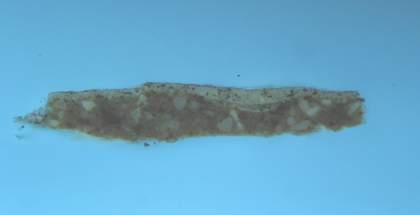
Fig.4
Cross-section through the greenish brown background at the right edge, photographed at x200 magnification in ultraviolet light. The tan coloured ground has on top a thin coat of transparent material that fluoresces.
The tan coloured ground is composed of red and yellow earth colours, black and blue verditer mixed up together and bound in oil (figs.3–4).2 It was applied smoothly overall, extending some way onto the tacking margins but not to their cut edges, which suggests that it was done in the artist’s studio rather than by a colourman.
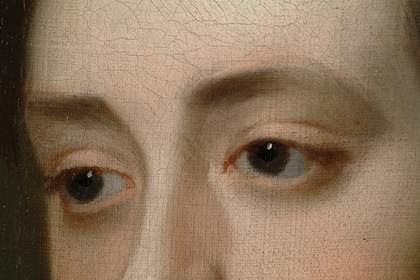
Fig.5
Detail of face, with sketchy brown first lay left visible for the darkest part of the eyebrows and the shadows under the eyes
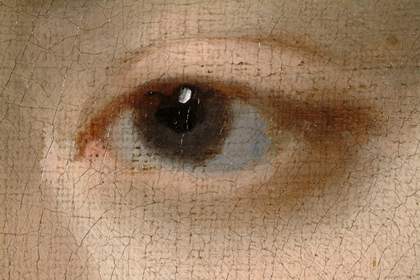
Fig.6
Close-up detail of her left eye
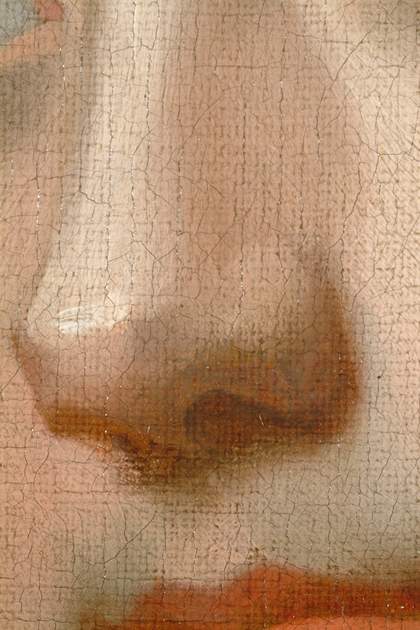
Fig.7
Detail of nose, with sketchy brown first lay left visible for the delineating shadows
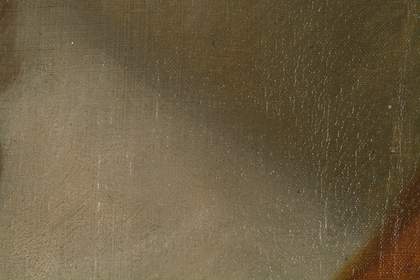
Fig.8
Detail of the neck, with sketchy brown first lay left visible for the darkest shadow
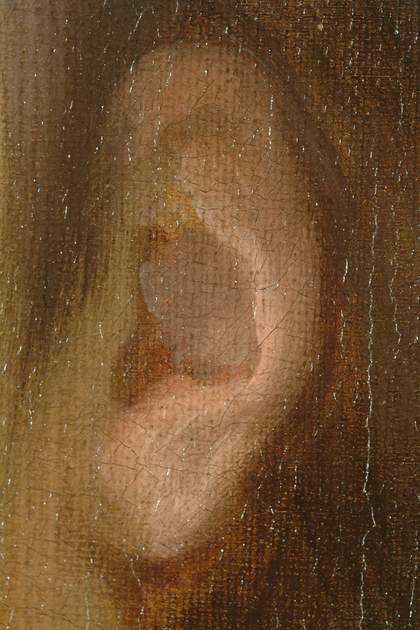
Fig.9
Detail of the ear, with sketchy brown first lay left visible for the darkest shadows
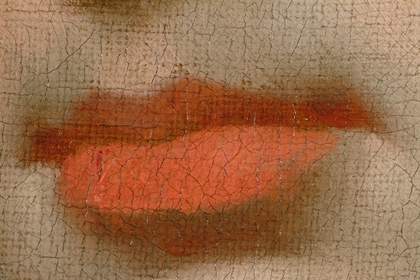
Fig.10
Detail of the lips, with sketchy brown first lay glazed over with translucent crimson paint for the upper lip and the shadow under the lower
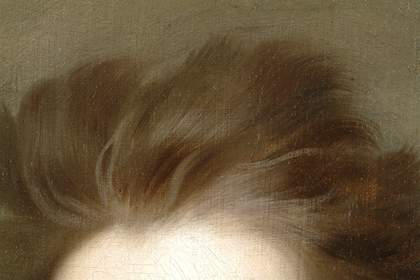
Fig.11
Detail of the hair, with sketchy brown first lay left visible on the right
No underdrawing is discernible with close examination or with infrared reflectography but this may be due to the presence of the tan coloured ground, which would absorb infrared light. Close examination of the head indicates that it was sketched in with thin brown paint (the first lay), which was left visible here and there to form the darkest shadows (figs.5–11). The first painting (or dead colouring) of the head and shoulders was done sketchily in cool, opaque, pale purplish flesh tones. At the same time the right side of the background was painted dark grey. Apart from its dark shadows the dress appears to have been begun in the opaque green mixtures we can see, mixed up separately on the palette and worked into one another on the canvas with lively brushstrokes. The principal pigments in these mixtures are green earth, lead white, blue verditer and yellow ochre. The darkest shadows were laid in first with dull greenish brown paint.
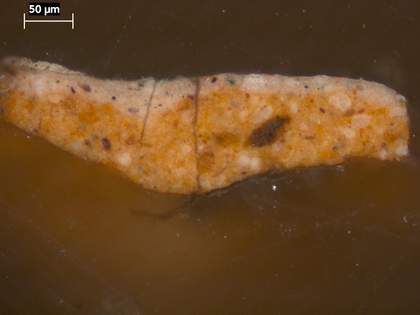
Fig.12
Cross-section though flesh paint between the sitter’s left eyelid and eyebrow, photographed at x320 magnification. From the bottom: tan coloured ground; first painting of cool flesh paint; second painting of warmer coloured flesh paint; trace of modern overpaint on left; varnish
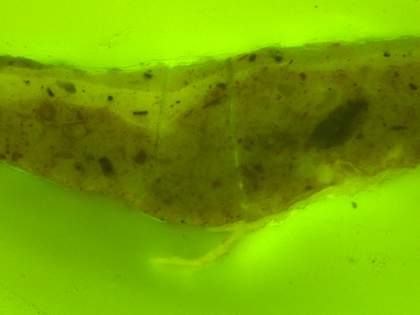
Fig.13
The same cross-section as in fig.12, photographed at x320 magnification in ultraviolet light with a blue filter
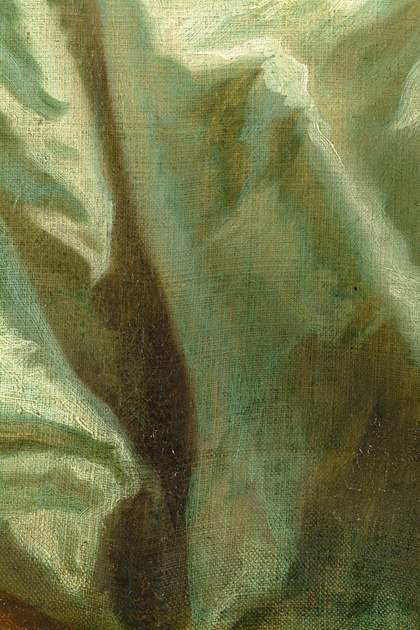
Fig.14
Detail of the drapery
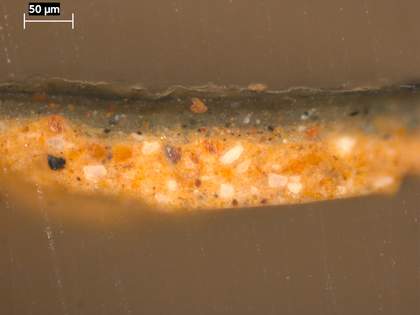
Fig.15
Cross-section through darkest shadow of the green dress between arm and bodice, before varnish removal, photographed at x360 magnification. From the bottom: tan coloured ground; thin, opaque underpaint; opaque greyish green underpaint; semi-opaque green mixture; thin dark glue glaze, again perhaps with a resinous component; varnish
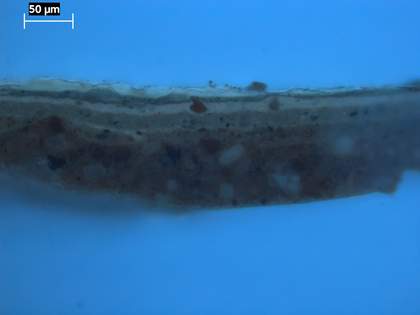
Fig.16
The same cross-section as in fig.15, photographed at x360 magnification in ultraviolet light. The semi-opaque green mixture fluoresces opaque, perhaps indicating a resinous component.
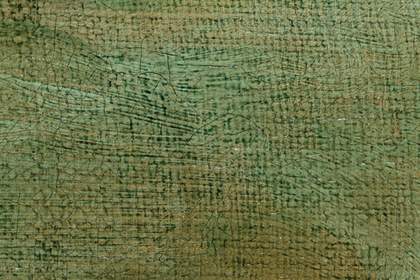
Fig.17
Close-up detail of residues of the final blue glaze of indigo in the dress
For the second painting of the flesh tones, the artist took bright, opaque mixtures, pinkish for the lights, greenish for the half tones, and worked them into his dead-colouring with mainly diagonal brushstrokes. It is not clear from the paint samples whether the dead colouring was completely dry at this point (figs.12–13). The darkest shadows of the dress were worked up with several quite complex paint layers to give the required depth of tone (figs.14–16), while the rest of the drapery was glazed all over with tones of greenish blue (fig.17), the main pigment being indigo. This glaze has suffered wear and tear and in most areas is now present only in the hollows of the paint film. Apart from this worn glaze, the painting is in excellent condition.
September 2020
